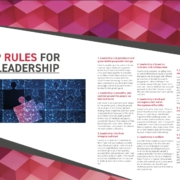Managing Creativity and Risk
Managing Creativity and Risk
Organisations usually take a view that to innovate is to take more risks, and so risk and creativity are conflated. As I was researching my book on business creativity, Sparking Success, I interviewed Sir Clive Gillinson, Managing and Creative Director of Carnegie Hall in New York City, who had a clear and specific perspective on balancing creativity and risk. Clive argues that risk isn’t necessarily a bad thing, but you have to possess the right perspective about holding the two conditions of invention and risk in balance: ‘You can’t run anything successfully without taking risks. My view is the greatest risk of all is trying to avoid risk because then you’re almost guaranteed to fail. So I’m an absolute believer in taking risks. I’m not interested unless we’re taking risks. We have got to be breaking new ground all the time, trying new things out. But the most crucial thing to me is not about taking a risk, which is fundamental, but it’s how you manage risk.’
Gillinson admits that he started out by taking risks which were probably unacceptable. When he moved from being a cellist in the London Symphony Orchestra (LSO) one day to being manager of the orchestra the next, he heard that the conductor, cellist and one of the greatest artists who ever lived, Mstislav Rostropovich, was going to be celebrating his sixtieth birthday with two orchestras. Clive went to Rostropovich’s manager and said, ‘This is crazy. Why is he doing this with two orchestras? It should be one orchestra so there’s a singular focus on him.’ She said, ‘Well, it’s such a massive project that each orchestra can’t afford it on its own.’ So Clive offered that the LSO would do it solo. And she said, ‘But you’re on the verge of bankruptcy,’ and they were on the verge of bankruptcy when Clive became the interim manager. That was the only reason he went into management in the first place – the previous managing director had lost his job as a result. But Gillinson retorted, ‘That’s the way it’s got to be done for Rostropovich. It’s such an extraordinary project for one of the world’s greatest artists, I’m sure we’ll find the money.’ At that, the manager went to Rostropovich, and she told him the story about this lunatic at the LSO and what he’d said, and he responded, ‘Well, if he believes in me like that, I believe in him. And if he’s a cellist as well, then that settles it!’ Rostropovich brought the project to the LSO, they did raise the money, and they were better off financially and artistically for having taken the risk.
Gillinson admits, ‘The fact is at that time I did not know how to calculate risk, so it was purely based on my view that this project had to happen in that way, and if I believed it, then I could get other people to believe it. But that was, I would say, an unacceptable risk. When I went to the board and declared, “We’ll raise the money,” they said, “Are you sure you can raise it?” I said yes, but obviously I had no idea except my conviction that it had to happen. Nowadays we would never do that. But my view about projects is, firstly, I’m not interested in good ideas. They have to be great ideas because who are you ever going to excite about just a good idea, and why are they going to give you money? It’s got to be extraordinary.’
Now, unlike the Rostropovich example, Clive will work out the strategy with his team for how the organization will implement the idea and how to raise money for it, but at the end of the day there is still risk. No matter how much you’re convinced yourself, you still have to convince other people. But at the same time, Gillinson can’t ever remember a situation where he couldn’t persuade others to back an idea if he and his team were absolutely convinced in the first place that the idea was amazing.
For example, creating the National Youth Orchestra of America was a huge demand, and Carnegie Hall decided on the level of risk they were willing to take before embarking on the project in earnest. They decided that if they could get a few founder patrons to donate a million dollars each over five years (because they felt it couldn’t be launched with just one year’s funding – it had to be five years at the very least), then they’d have the possibility of underpinning the project with long-term funding. The team thought this was going to cost something like ten million dollars over five years. If a critical mass of founder patrons could be found who would give sufficient backing so that everybody believed it’s got to happen and will happen, then they’d raise the rest of the money. And that’s exactly what they did; Carnegie Hall succeeded in getting three or four founder patrons at a million dollars each, and that was sufficient to provide the launchpad.
Clive recollects, ‘If we were able to get several people to put in a million as founder donors, that tells you about the importance of our idea. I mean, that’s a lot of money to commit! You would never be able to sell it if you haven’t got a great idea. There wouldn’t be a hope in hell. The fact is, by going out and saying we’ve got to raise three or four founder patrons, we were effectively checking risk because it meant that if nobody had come in, we would have known it wasn’t a compelling enough idea, and we wouldn’t have gone with it. If nobody had given anything, you have to listen to that. So that was how we approached that project – you eliminate some of the risk, and you calculate the rest of the risk.’
Once you have those platform advocates, it’s simpler to attract other supporters because they see that the idea has already been vetted. After that stage, it’s much easier to raise money for something that exists. As Clive elucidates, ‘The minute the National Youth Orchestra play, and people can hear what it is, and they can hear how extraordinary it is, it’s much easier to be inspired about giving money than people selling you an idea, where you have to believe it when they say, “This is going to be one of the greatest National Youth Orchestras in the world. It’ll be a phenomenal orchestra with huge impact in terms of international understanding as they travel the world as youth ambassadors for their country.” The theory is always less powerful than the fact. The minute it exists, it’s much more fundable.’
Gillinson set Carnegie Hall a target: they would only go public with the National Youth Orchestra and put it on the launchpad if they had raised three to four of the ten million dollars they required to fund the first five years. Thereafter, they’d still be raising more money, but by that time they would be flying with commitments around a real project rather than a concept. If the worst came to worst after two or three years, it’s possible that Carnegie may have had to scrap the Youth Orchestra if they simply couldn’t raise any more money. But the initial risk they had to take related to the fact that they knew that once the orchestra had performed, people would be blown away by it, and that fact therefore would draw in the rest of the money, and that is precisely what happened. Clive recalls, ‘We definitely didn’t raise the full five years of funding before the orchestra played. You’ve got to try your very best to create a position where you’re not taking one hundred percent risk. We’d eliminated thirty to fifty percent of the risk before we started, whereas I hadn’t eliminated any of the risk at the LSO with the Rostropovich decision.’
Clive is really speaking about the power of displaying a prototype rather than merely summoning an image of what an idea could be. This practice is core to Pixar Animation Studios’ success with their ever-present habit to ‘Display’. If you are walking through the Studios, you can’t help but encounter work-in-progress, whether it’s an open screening of the dailies of a film, or a gallery of character studies or storyboard drawings. These displays serve as an instant visual representation of the state of play, inviting everyone, even those just walking by, to contribute. Thinking of work as in a state of perpetual Beta and inviting comments, questions and improvements facilitate learning, widen ownership of the challenge, and ultimately lead to better outputs. All told, Pixar will often produce twelve thousand storyboard drawings to make one ninety-minute feature film.1 They wholeheartedly buy into the power of prototyping.
Gillinson remembers another aspect of eliminating risk was not only attracting donors at the beginning but attracting world-famous artists to collaborate: ‘I knew that, in a country the size of America, the standard of the students would be among the greatest in the world. But I also knew we had to get a great conductor for the National Youth Orchestra at the beginning. That would also de-risk the project. I managed to get Valery Gergiev, and Gergiev bought it sight unseen because he believed in Carnegie Hall, and this is where having a brand has huge power. But you have to have such a compelling idea, and you’re pitching it at a level that’s right because without a great conductor, we wouldn’t have gotten concerts and television in Moscow, St. Petersburg, and the Proms in London. Without Gergiev, we wouldn’t have gotten Joshua Bell, one of the world’s great violin soloists. So all the pieces have to interact with one another, and if you go for a safer approach, if we’d gone for a conductor who wasn’t one of the world’s superstars, none of the other pieces would have fallen into place. You’ve got to go for broke on every single part of implementation. I knew we had to get the international concerts and television, but we also had to communicate that Carnegie Hall was an institution that will only do things if they’re extraordinary. With all our projects, we set out to create a magnet for talent, so all the parts work together to ensure that every element is world class.’
Once a company has the reputation for ‘going for broke’ on absolute quality with every offer to the market, there is a shift in the customer-supplier relationship whereby market research is to a large extent disintermediated by the trust in the supplier. In other words, the customer trusts that a new product or service is worthwhile because they trust the source of the offer. Without the permission to invent things the world doesn’t know it needs, a company can never reach tomorrow. Market research only tells you about what already exists or what the world already knows.
Clive recognises this truth: ‘Steve Jobs sold things that market research would have told him he couldn’t sell. But Jobs’ view was always, “I’ve got to create something that people want, but they don’t know they want it until I’ve created it.” That was exactly the same with the Walkman at Sony. Sony did all the market research around the Walkman, which told them it wouldn’t work. Japanese companies were not necessarily known at the time to be huge risk-takers. Sony chairman Akio Morita was, however, and he said, “I know it will work. We’re doing it. Never mind the market research.” He believed in it, and of course it was an extraordinary success.’
To achieve radical creativity requires questioning how much we are managing ourselves and our teams in terms of what is acceptable novelty. Are the boundaries we set as leaders too tight? Exponential creativity perhaps means managing less. Highly ‘manageable’ creativity will most likely at best earn incremental improvements rather than revolutionary ones. As author and educator Richard Farson concluded with his characteristically radical candour: ‘Real creativity, the kind that is responsible for breakthroughs…always violates the rules…. In most organizations, when we say we desire creativity, we really mean manageable creativity. We don’t mean raw, dynamic, radical creativity that requires us to change…. The problem with creativity in a lot of companies (and a lot of individuals as well) is that they just don’t want to go through all the necessary changes. They want creativity the easy way. Manageable creativity means lukewarm, half-ass creativity, which unfortunately usually means no creativity at all.’ 2
1 Ed Catmull, Creativity, Inc. (London: Transworld Publishers, 2014).
2 Richard Farson, Management of the Absurd (New York: Simon & Schuster, 1997) 131.
For more on this topic, please see my book, Sparking Success: Why every leader needs to develop a creative mindset (Kogan Page, 2023).











